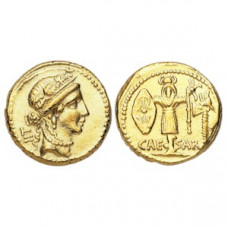Reproduction Aureus of Julius Caesar - Trophy
Obverse: Female head right wearing diadem and oak-wreath, most likely Venus, Pietas or Clementia. In the left field the Roman numerals LII.
Reverse: Gallic trophy consisting of horned helmet, coat of mail, oval shield, unusual dragon-headed carnyx (war trumpet) and to the right an axe. Text in the exergue CAESAR.
History: This aureus was struck at the height of Julius Caesar’s campaign against Pompey and his allies, which climaxed on 9 August, 48 B.C., when Caesar defeated Pompey at the battle of Pharsalus. It is a self-promotional coinage that names only Caesar and bears the reverse type of a trophy of Gallic arms and armour. This design not only celebrates his success in the Gallic Wars, which culminated in the capture of Vercingetorix, the celebrated chieftain of the Arveni, but it diverts attention from Caesar’s less honourable civil war against his fellow Roman Pompey.
An unusual feature of this coinage is the numeral LII on the obverse. It is generally accepted to represent Caesar’s age, 52, at the time this coinage was struck, which would have been in the aftermath of the Battle of Pharsalus.
The identity of the large detailed female portrait on the obverse is far from certain. The goddess or personification wears an oak wreath. She is most likely the goddess Venus, from whom Caesar was believed to have descended, however some have identified the image as Clementia or Pietas.
This was the first aureus any Roman had struck for more than a generation. It is typical of gold of the Imperatorial age in that it was struck under extraordinary circumstances, and though these aurei are very rare today, they must have been struck in large quantities since the companion denarii with the same design survive in large numbers. To date, there are only 10 specimens known of this coin.
Date: Travelling military mint with Caesar 13 July 48 - 47 BC
Diameter: 2.0cm
Tags: Aureus, Julius Caesar, Gold, Venus, Pietas, Clementia, Trophy, Gallic, Travelling Mint, Roman, Reproduction, Replica, Coin




